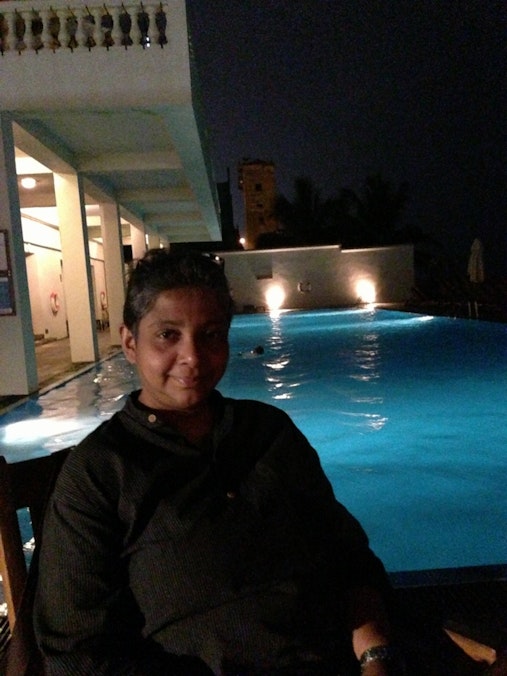When South is North: redirecting the compass, reinvigorating Australian arts
Yasmin Tambiah
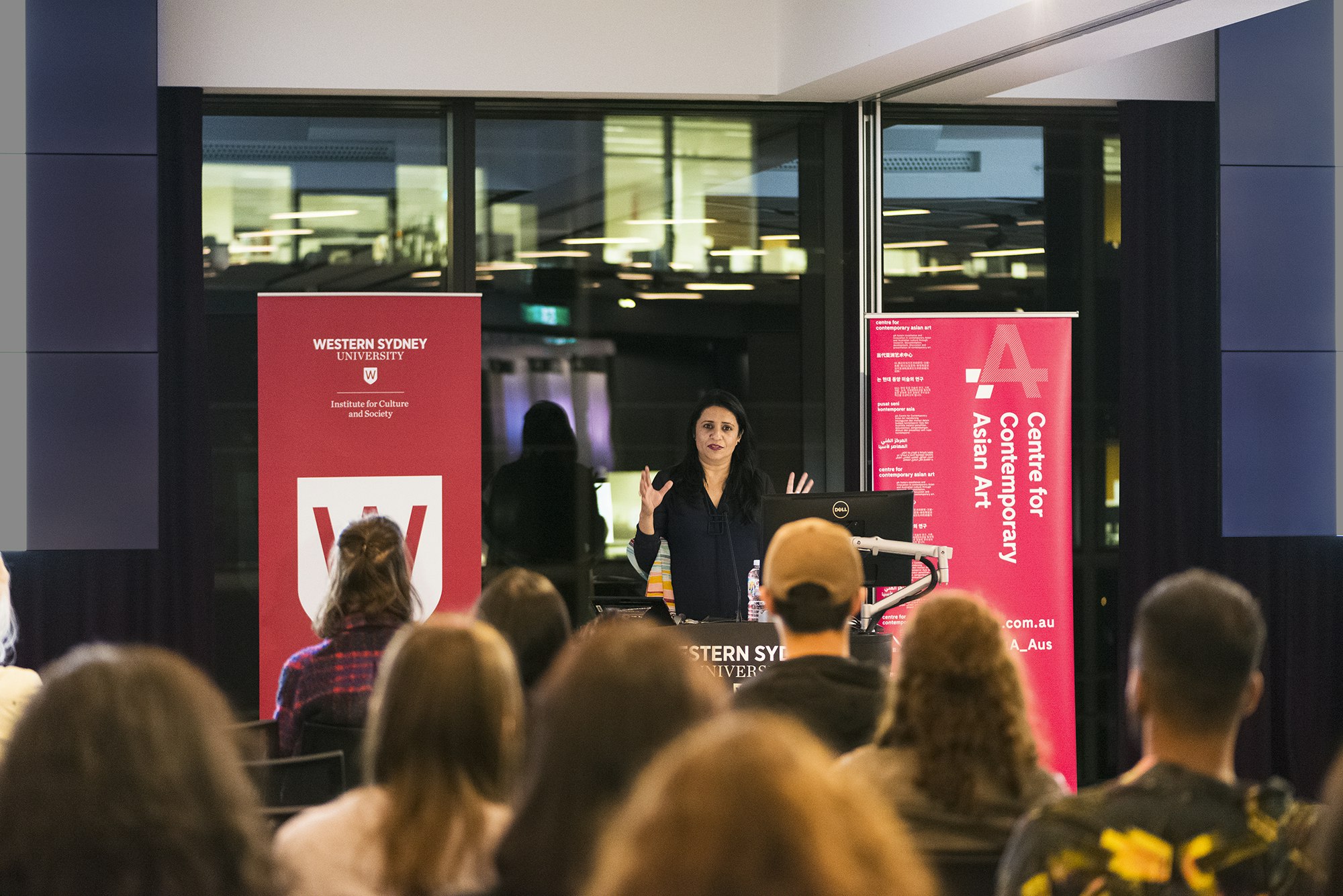
Adeela Suleman keynote address at When South is North: Contemporary Art and Culture in South Asia and Australia symposium, 16 August 2017, Western Sydney University, Parramatta campus. Produced by 4A Centre for Contemporary Asian Art in association with the Institute for Contemporary Culture and Society, Western Sydney University; photo: Kai Wasikowski.
For many Australians, regardless of ethnic origin, the idea of Asia still conjures up East and Southeast Asia, rarely South Asia, problematic as such divisions of continents and geographies are. While people of South Asian descent have a long history both with and within Australia, acknowledgement of the range of their contributions has, until recently, been slim. Within arts spaces, this recognition has been even slimmer. But some art institutions are beginning to change this. The recent symposium When South is North: Contemporary Art and Culture in South Asia and Australia, held on 16 August 2017 in Parramatta, home to a large South Asian community, made public a turn of direction by the 4A Centre for Contemporary Asian Art. Based in Haymarket in Sydney’s Chinatown, for over twenty years 4A has played a leading role showcasing contemporary Asian artists working in Australia and Asia. It has developed collaborations with and among artists, nurtured artistic and institutional networks, and hosted discussion forums to educate the public. Although South Asia has been represented among works commissioned or displayed by 4A, this has been extremely infrequent. Two years ago, 4A revisited its programing and made a considered commitment to rectifying that pronounced lack. As 4A’s Director Dr Mikala Tai explained in her introduction to the symposium, while there has been accelerated growth among South Asian populations in Australia over the past decade, ‘in terms of important work that allows our population of South Asian heritage to walk into our museums and see themselves reflected back, we are not doing a good enough job.’ It is a consideration applicable not only to 4A but also other art institutions. This symposium was part of 4A’s five-year project to bring contemporary South Asian art to the foreground. It publicly signalled 4A’s special attentiveness to collaborations in and with South Asia, and discussions and support of visibility. Consequently, South Asia will be better integrated into 4A’s continuing curation and promotion of contemporary art from across Asia as well as work by Asian-Australian artists. The symposium was delivered with project partner the Institute for Culture and Society (ICS) at Western Sydney University, especially Professor Ien Ang, and supported by the Australian Council for the Arts, with philanthropic support from The Keir Foundation, Gene Sherman and other supporters of 4A. This paper highlights particular threads of presentation and discussion on that day, rather than being comprehensive.
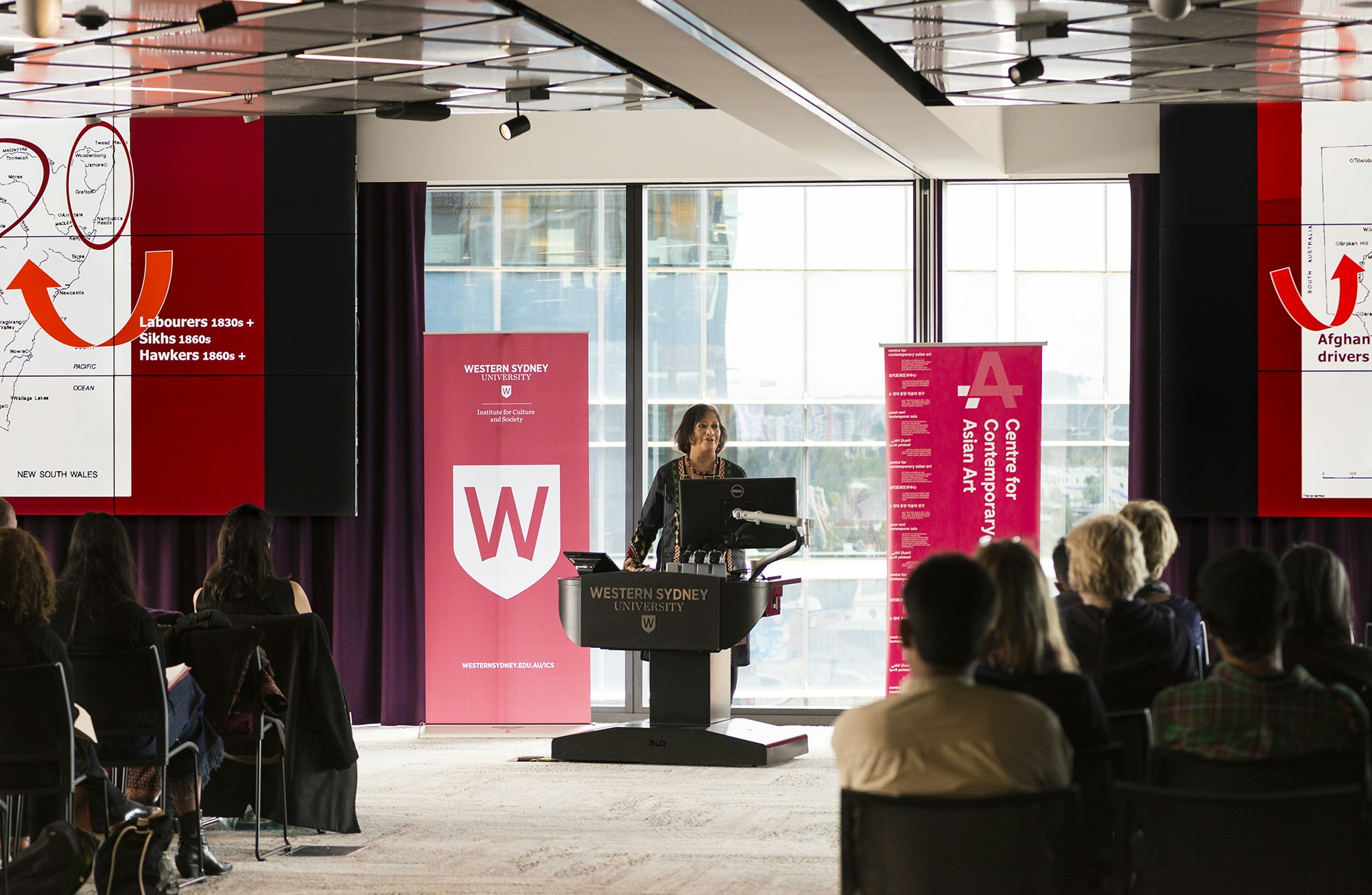
Professor Develeena Ghosh presenting at When South is North: Contemporary Art and Culture in South Asia and Australia symposium, 16 August 2017, Western Sydney University, Parramatta campus. Produced by 4A Centre for Contemporary Asian Art in association with the Institute for Contemporary Culture and Society, Western Sydney University; photo: Kai Wasikowski.
South/North/Australia/South Asia: backdrops
The symposium was jointly presented by 4A and ICS. Professor Paul James, Director of the Institute, remarked that ICS, from its interdisciplinary, boundary-crossing approach, attempted to understand a world where the arts are essential to comprehending culture, where ‘culture is the meaning of everything’. Drawing attention to the symposium’s title, When South is North, James pointed to the utility and limitations of terminology. The terms ‘south’ and ‘north’ ‘are important political appellations for designating difference in a globalising world,’ standing in for developing or underdeveloped versus developed. But the assumptions that flow from such designations no longer work. Categories do have uses and can be worked with, but also need to be criticised and contested. ‘South Asia’, for instance, can be referenced as an entity defined by a common history, but it is also simultaneously defined by differences, diverse multiplicities and complex hostilities. Australia is in the southern hemisphere but regarded as part of the global north; South Asia is in the northern hemisphere but considered part of the global south. What is common to everyone regardless of location, he noted, is that ‘we are all postcolonial citizens in a globalising world’.
Complex relationships between Australia and South Asia were in place even when the world was less global and still colonial. As Professor Devleena Ghosh, Director of the Indian Ocean and South Asian Research Network (IOSARN) at the University of Technology Sydney pointed out, from the late 18th century until 1840, all supplies to the Australian colony came from India, not Britain. The famed Afghan cameleers were only one group of South Asians who arrived here in the 19th century. Others included labourers, household staff of British bureaucrats, itinerant hawkers, circus performers and magicians, a number of whom settled in New South Wales. Many, especially in northern regions of the state, intermarried with Aboriginal people; as an interviewee told Ghosh, ‘My grandfather said, nobody else would talk to us’. In the 20th century, Indian soldiers served and died at Gallipoli. In the late 1940s the Indian Seamen’s Union refused to stock Dutch-commanded ships travelling to Indonesia to recover the Dutch colony, causing many of the Indians who protested, and who were largely poor, to lose their jobs. As Ghosh said, ‘It’s important to remember these things, especially in the 21st century when we are hardening our boundaries and trying to become much more mono-cultural than we have been right from 1792 onwards. Our history is not an all-white settler history; it’s a much more complicated multi-coloured history.’
In the context of creative exchanges and contributions, Ghosh pointed out that a long history of literary production in Australia also connects the two regions. Through examples ranging from Mena Abdullah’s The Time of the Peacock (1965), Sri Lankan-Australian Yasmin Gooneratne’s A Change of Skies (1991) and Bangladeshi-Australian Adib Khan’s Seasonal Adjustments (1994), to Suneeta Peres Da Costa’s Homework (1999) and Manisha Amin’s Dancing with the Flute (2012), a reader could trace the movement from immediately diasporic situations and tenuous or contested belongings to complete comfort at being Australian. An author such as Michelle de Kretser was simultaneously representative of both Australia and Sri Lanka, raising, in Questions of Travel (2012), the issues of travel as a choice (for those privileged) and travel as a compulsion (for those not, such as refugees). In her presentation, Ghosh concluded that this is an exciting time to be in the arts and cultural arena in Australia, because cultural producers in a range of practices and media, including film (e.g. Salaam Namaste produced in 2005), are able to look at Australia and South Asia in fresh ways. Such initiatives reveal the long-standing relationship between the two regions, often obscured by both colonial and White Australia: ‘It’s time to acknowledge that our relationship goes a long way, and to celebrate that history rather than hide it.’
Focus presentation: Reena Kallat
How does one claim political/separating/nationalised ownership of native, natural forms that do not end at territorial boundaries?
How does memory work, whether for a person or a community? How do we choose to remember the past? In what ways can an artist intervene in historical controversies that continue to fracture the world? Such considerations are braided into Mumbai-based Reena Kallat’s work. Spanning a variety of practices including drawing, photography, sculpture and video, and widely exhibited across the globe, her symposium presentation discussed working across cultural and national boundaries. The Partition of India in 1947 at the conclusion of British colonial rule, which resulted in the creation of the separate nations of India and Pakistan, deeply haunts Kallat’s art. So do the outbreaks of intense violence that have periodically scarred Mumbai in the past two and a half decades (1992, 2002), and which she attributed to the legacy of Partition. Among the examples Kallat discussed (and selectively presented here) are works that utilise the rubber stamp, an essential part of India’s bureaucracy. It is the state’s little tool deployed as a means of sanctioning—including and excluding, affirming and denying—insisting on borders and separations where none might have existed before. The installation Penumbra (2006) is a stainless steel cradle holding in suspension the (infant) body as a form of the disputed territory between India and Pakistan, namely Pakistan Occupied Kashmir. The constituting stamps have names of freedom fighters. The work conveys a sense of ‘not knowing the fate of these citizens held in suspense, not knowing which side they belong to’. Crease/Crevice/Contour (2008) is a series of ten photographs tracing the changing Line of Control between India and Pakistan from October 1947 to December 1948 over Kashmir. Names of those who signed a peace document calling for a monument for the victims of Partition to be built at the Wagah-Attari border are etched in red stamp marks on the back of a female body. Kallat noted that the brunt of Partition was borne by women and children, and the histories of women who were raped or abducted and marked for ownership are also tied into this work.
Hyphenated Lives (2015) a series of more recent work depicting hybrid flora and fauna drawn on paper always has electric cable wire (a means of communication and/or barbed wire) as a component. They are imagined species of birds, animals, flowers and trees, ‘hybrids from countries that are politically partitioned but have long-shared histories’. An example is the Sun-poe, a hybrid of Israel’s Hoopoe and the Sunbird of Palestine. National symbols, meant to unite people from a particular region, have been separated by politics. Through her art Kallat symbolically reunites these. The hybrid union however does not sit easily; the point of joining is a little askew or otherwise uneven, as if to convey that reuniting separated people is neither a given nor easily done. In the natural world, species do not stop and start based on national boundaries, although they may become discontinuous because of a natural barrier such as a mountain range. How does one claim political/separating/nationalised ownership of native, natural forms that do not end at territorial boundaries? The hybrids are ‘a proposition for the future, or perhaps species that existed in the past’, she explained, before being separated into difference as in natural history classifications.
In response to a question posed from the gathered attendants—what is the artist’s process for finding animals and birds to make the new creatures?—Kallat revealed that this grew out of prior work on national birds and animals from India and Pakistan. Her interest is in how ideas are clung to because of resurgent nationalisms: ‘As artists we try to claim that space back. The fact that you make art is a political act, and you are reimagining things.’ To another question, whether she deliberately chose not to make religion a basis of her work on Partition, or whether it was simply not included, Kallat responded that while religion was a primary issue at state level, in the personal stories she heard from people who experienced Partition rarely would they speak ill of the other community. In the context of the largest ever migration in human history, involving over 10 million people, across communities there was empathy on what happened. Her work did touch on religion, but without emphasising it.
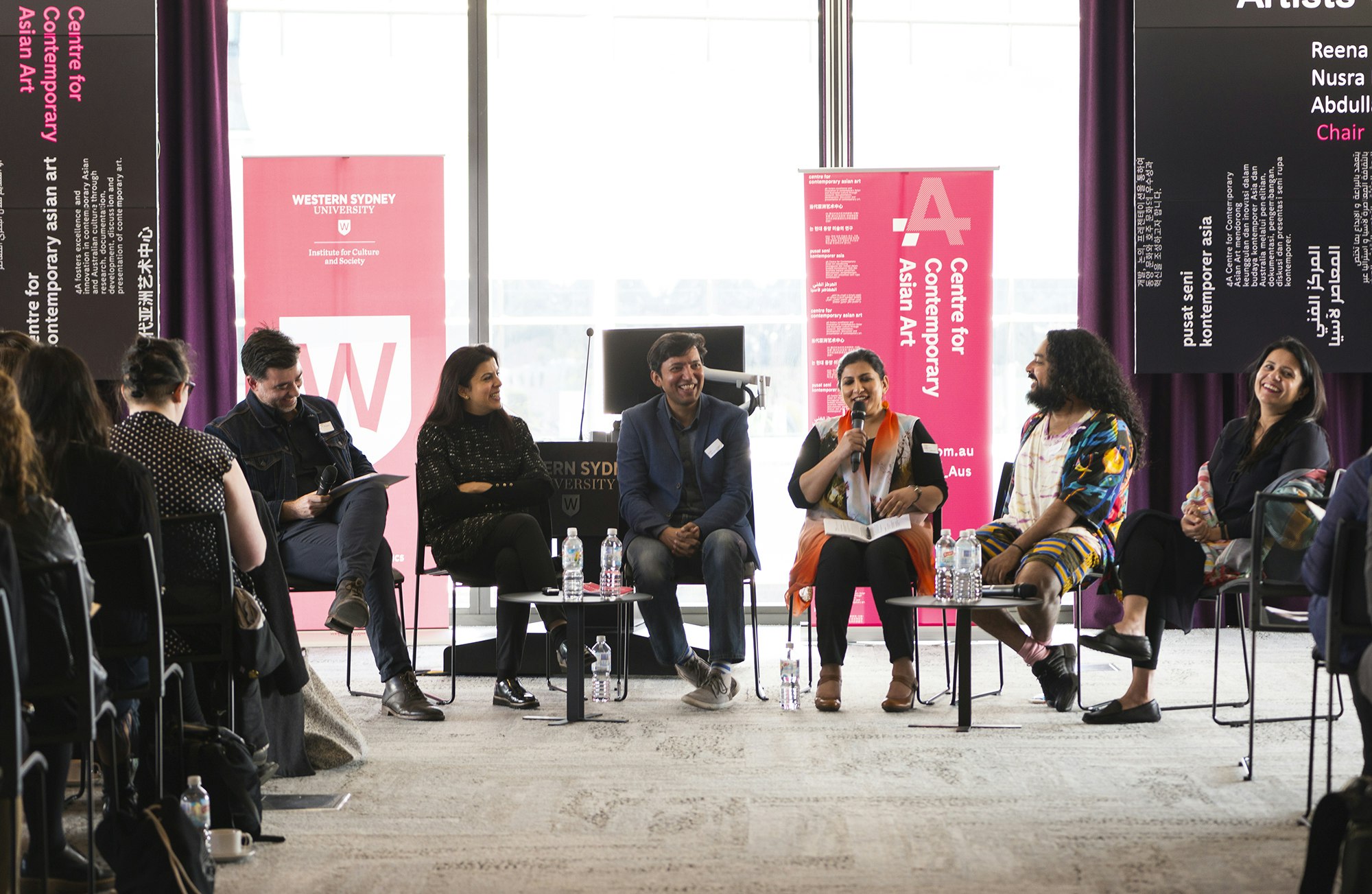
From left to right: Pedro de Almeida, Renna Kallat, Dr Abdullah M. I. Syed, Nusra Latif Qureshi, Ramesh Mario Nithiyendran and Adeela Suleman. When South is North: Contemporary Art and Culture in South Asia and Australia symposium, 16 August 2017, Western Sydney University, Parramatta campus. Produced by 4A Centre for Contemporary Asian Art in association with the Institute for Contemporary Culture and Society, Western Sydney University; photo: Kai Wasikowski.
Panel 1: Art in, of, from South Asia? Artists working across cultures and geographies
‘Why do you need a monument? Women don’t see the world that way, perhaps, and they are very good at raising ghosts from the past and making you uncomfortable…about the past which you have chosen to forget...'
The day’s first panel brought together artists based in geographical South Asia as well as artists of South Asian descent who live in Australia. All had worked in or exhibited at multiple international locations, and their work was readily accessible and comprehensible on a global platform.
The panel’s moderator, 4A’s Program Manager Pedro de Almeida, referenced one of Reena Kallat’s works—‘Wash your guilt, build a memorial’ (2014), one of a series of lettered images made of salt sprinkled on the beach, which waves gradually washed away—before asking how each of the panellists had played with the idea of monument and counter-monument in their work. Kallat responded by stating that ‘there is this long guilt we carry, and a way to wash off our guilt is by building a memorial, a way of trying to overcome or rest peacefully with a lot of the tragedies that happen’, including at a national level. Only this year has a Partition Museum been built, 70 years after, in Amritsar. Adeela Suleman, who is based in Karachi, said that her approach to a monument, of monumental size, ‘is like a remembrance of not committing the crime again’. She perceived post-WWII German monuments as both celebrating death and serving as reminders of what cannot be repeated. Referring to her own big-scale works, which are profoundly informed by the endemic violence in Karachi and denizens’ unabated struggles to cope and survive, Suleman felt they needed to be aesthetically attractive at first encounter for the viewer, whose gaze is then directed to the detail of the installation which depicts death and its instruments; exaggerated size was needed to catch people’s attention. Kallat proposed that monuments serve both as devices for remembrance as well as a means to educate. The Partition Museum, for instance, will display items that were essential for people to carry in order to rebuild their lives, such as identity cards. In addition, a monument is ‘a way to come to terms with how humans behave in such situations. You can demonise either side, but [what matters is] the side of us that manifests itself in such moments, reflective of a particular time, a situation.’ Dr Abdullah M. I. Syed, who was born in Karachi and now lives in Sydney, suggested examining the three terms: monument, monumental and memorial. He proposed connecting a monument with a body, such as Jinnah’s monument or the Taj Mahal. ‘Artists…are taking this idea of monument and making monumental work, they are amplifying it to that idea.’ He also observed that large museums resemble large mausoleums and need monumental works to occupy that space.
Discussion then turned to comparisons of scale, the monumental versus the miniature. Ramesh Mario Nithyendran, who was born in Sri Lanka and migrated to Australia as an infant, has moved from creating small-scale ceramic figures to larger, sometimes monumental idols. He expressed an interest in how bodies are sculpturally represented in public spaces, both in Australia and South Asia. During recent trips to South India and Sri Lanka, Nithyendran noted how public art has a polychromatic palette, in contrast to Australia’s, and the ‘semi-veiled, unveiled erotic depictions in public space, versus say something like the statute of Captain Cook, phallic but completely implicit’. Nusra Latif Qureshi, who trained in Lahore in miniature painting and moved to Melbourne for postgraduate studies and continues to live in Australia, commented that the monumental was elided into masculinity and, given prevalent gender biases, a female artist was less likely to be noticed if she was not producing ‘big’ work. Her own almost nine-metre long print, Did you come here to find history? (2009) garnered for her more international recognition than her miniatures. Suleman countered that for a considerable period of time, the miniature was the only kind of art from Pakistan being exhibited abroad. In regard to the perceived current preference for monumental work, Suleman underscored ‘the mood changes of the art world’ and the time-dependent nature of art preferences. Large-scale works also brought their own challenges in terms of production, storage and shipping. Qureshi reflected further on the relationship between gender and monument: ‘Why do you need a monument? Women don’t see the world that way, perhaps, and they are very good at raising ghosts from the past and making you uncomfortable…about the past which you have chosen to forget. I think it’s heavily tied to the postcolonial issue and postcolonial history that ties Australia with South Asia.’
The panellists also addressed the value of artistic networks, both locally and across South Asian borders, collaborations that enabled artists from within South Asia to spend time in each other’s countries, as well as for overseas visitors to engage with artists in South Asia. Suleman, coordinator of Vasl Artists’ Association in Karachi, noted that networked connections with collectives such as Khoj International Artists’ Association in Delhi, Theertha Artists’ Collective in Colombo and Britto Arts Trust in Dhaka enabled the development of not only professional ties but also friendships, with positive implications for community building and programing. Travel, in particular, enabled artists to appreciate both the similarities and differences in culture, but visa issues continue to be a major hurdle. As Suleman said, ‘There is no animosity between the people, it’s the governments’ policies that affect [interactions].’ Qureshi also saw artistic collectives as enabling self-reliance within South Asia, rather than reliance on a purportedly superior West; collectives as a platform that enabled ‘making connections rather than being patronised’.

Vidya Shivadas presenting at When South is North: Contemporary Art and Culture in South Asia and Australia symposium, 16 August 2017, Western Sydney University, Parramatta campus. Produced by 4A Centre for Contemporary Asian Art in association with the Institute for Contemporary Culture and Society, Western Sydney University; photo: Kai Wasikowski.
Focus presentation: Vidya Shivadas
The process began in 2015, in the midst of nation-wide student protests decrying issues such as political interference and caste-based discrimination.
Vidya Shivadas is a Delhi-based curator and Director of the not-for-profit Foundation for Indian Contemporary Art (FICA). Interested in how the ecology of art infrastructure is being developed 4A selected FICA to present based on similarities to itself, especially institutional size and preference for multiple funding sources. FICA, Shivadas explained, has engaged with questions such as how art education works and where programs are delivered, in addition to considering how to ‘broaden the audience for contemporary Indian art, enhance opportunities for artists, and establish a continuous dialogue between the arts and the public through education and active participation in public art projects and funding’.
Besides supporting individual artists, FICA’s public art grants program operates on the basis that ‘all the projects come back to questions of communities, ecologies and dialogue’. The Gram Art Project collective, for instance, operated in the economically depressed Vidarbha region of Maharashtra, known for farmer suicides and the cultivation of genetically modified cotton. The art group farmed in the village and drew together artists, activists, farmers and local youth. A FICA public art grant enabled the group to organise a land art festival, growing crop images on farms and building watch towers so that the local community could view the compositions; ‘there were constant discussions about what the role of art itself is in such a context.’ A parallel installation, ‘Are you Nero’s guest?’, enquired why the rural agrarian crisis regarding farmer suicides and emigration from the area was not in the broader public consciousness. Shivadas underscored the importance of the case study because it examined the connections between ‘genetically-modified seeds, poisoning of the soil and death of farmers who are the primary producers’, while compelling the need to consider local interventions and how issues are being dealt with in situ. She suggested that the responsibility of art organisations is to draw meaningfully from these artistic initiatives and relay these conversations into and through the wider system.
FICA’s public art grants also supported initiatives such as Antarrashtriya Khirkee (International Khirkee) organised by Aastha Chauhan. The program aspired to reorient people’s views and encourage neighbourliness and integration in the tension-filled Khirkee urban village in South Delhi, which has diverse local and immigrant communities and is subject to the stresses caused by massive gentrification. For example, the opportunity to learn hip-hop from YouTube enabled the neighbourhood’s children to access global culture even though they were denied entry into the top-end, therefore cosmopolitan, shopping malls opposite.
A key FICA project in the area of art education was the Students’ Biennale in Kochi, envisaged as a means to galvanise students from government art schools across India, thereby reinvigorating the art schools themselves, in a multifaceted project as part of the Kochi-Muziris Biennale. Many art schools are of long standing, having started under colonial rule, but a number were poorly resourced today. Fifty-five art schools from across India were engaged, with a team of fifteen curators. The process began in 2015, in the midst of nation-wide student protests decrying issues such as political interference and caste-based discrimination. The curators were constantly challenged to think through what the Students’ Biennale could be, not simply on selecting artists but the kind of cultural framework to be used and what the interventions could produce. Students themselves were challenged to think about the current multiple impacts on their lives – strikes, displacements, learning lives, working lives. Engaging with practitioners in such a context, art organisations are challenged to think about where organisational intervention happens. ‘It is an evolving question,’ noted Shivadas. To an audience question as to whether there was any way to gauge the impact of art organisations in the public sphere, especially in regard to audiences or whether it made a difference in a community’s thinking, Shivadas responded that assessment is always difficult when working in a field that is not easily quantifiable. ‘In the initial years we had a lot of anxiety, we thought we must know what is actually happening to now where we say we know something is happening; we have to watch very carefully to see that because it’s not showing up in the way we expected.’
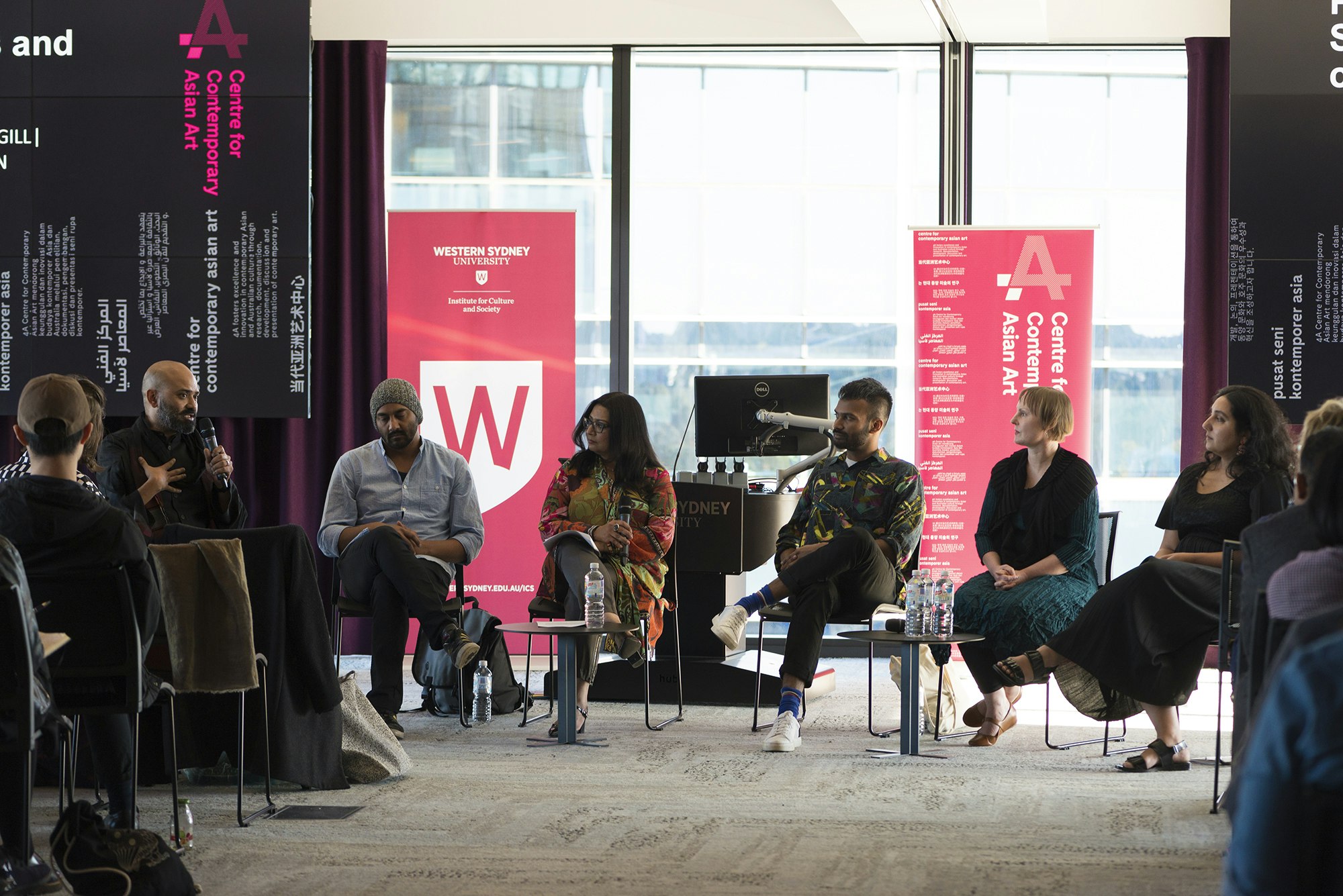
From left to right: Dr Sunil Badami, S. Shakthidharan, Dr Mehreen Faruqi, Gary Paramanathan, Melanie Eastburn and Amrit Gill. When South is North: Contemporary Art and Culture in South Asia and Australia symposium, 16 August 2017, Western Sydney University, Parramatta campus. Produced by 4A Centre for Contemporary Asian Art in association with the Institute for Contemporary Culture and Society, Western Sydney University. Photo: Kai Wasikowski.
Panel 2: Situating South Asian arts and culture in Australia
To the question, what do you think South Asian-Australian culture is, respondents pointed to the difficulty of describing a generic South Asian culture given the number of countries, each internally often multi-ethnic or multicultural, that constituted South Asia.
The day’s second panel focussed on conversations about situating ‘South Asian arts’ and culture more broadly in Australia. Chaired by Dr Mehreen Faruqi, a Greens Party member of the NSW Legislative Council and originally from Pakistan, panellists spanned different creative practices and Australian art institutions. They included Dr Sunil Badami, media personality and writer; S. Shakthidharan, founder and artistic director of Western Sydney arts company Curious Works; Gary Paramanathan, currently at the Australian Film, Television and Radio School (AFTRS); Melanie Eastburn, Senior Curator of Asian Art at the Art Gallery of New South Wales; and Amrit Gill, Senior Manager, International Projects at the Australian Council for the Arts.
To the question, what do you think South Asian-Australian culture is, respondents pointed to the difficulty of describing a generic South Asian culture given the number of countries, each internally often multi-ethnic or multicultural, that constituted South Asia. The impossibility of homogeneity therefore characterised South Asian-Australian culture too. Generational differences had an impact on what became defined as culture. First-generation immigrants were more likely to preserve their culture from the historical moment of their migration, keeping it static while referring to it as the authentic culture from ‘back home’. Meanwhile, the cultures in their country of origin had changed with the flow of history. For children of such immigrants, growing up in Australia presented the challenge of working out their cultural location in a society still pushing for homogeneity on what constituted ‘Australian’. As Gary Paramanathan, an Australian of Sri Lankan Tamil descent noted, ‘We look at our parents who seem to be frozen in time, and then we look at contemporary Australian culture, [and] it has no relevance or reference to us’. In comparison, S. Shakthidharan, prompted by his own experience of growing up in Australia in a Sri Lankan family where classical Tamil/South Indian culture offered a different way to think about the world, reflected on the utility of the idea of South Asian-Australian culture: ‘it offers an opportunity to interrogate what we want to do with the possibility of it’. The capacity to inhabit a range of different cultures could prompt the question, coming from that multiplicity of perspective, in what ways can one influence how Australia should now be shaped?
Australian arts organisations have a significant role to play in developing ties with geographical South Asia and its artists as well as curating and promoting the work of South Asian-Australian artists. Amrit Gill, from the Australia Council for the Arts, reflected that Australia’s cultivation of ties with South Asia was promising because it was not the replication of a process whereby colonial ties were simply re-inscribed in the contemporary era. Rather it was a ‘reciprocal exploration of common interests’. Melanie Eastburn, speaking about the Art Gallery of New South Wales, pointed to how the controversy around the provenance of certain Indian sculptures, and Australia’s eventual decision to return pieces to India, had strengthened relations between the two countries, opening up several new research areas. In collection building, focus was gradually changing from the historical to the contemporary.
While cultural relationships at institutional level between Australia and South Asia were transforming in a positive manner, the role of Australian institutions in curating and presenting contemporary South Asian art and contemporary South Asian-Australian artists was not especially strong. The feasibility of Dr Sunil Badami’s suggestion to consider a ‘fertile’ middle space between cultures that can be claimed by artists, and for conversations among all Australians on ‘where are we now, and where do we want to go, and how do we get there’ need to be considered in a context inimical to reflecting Australia’s diversity. As Paramanathan indicated, curators and art institutions remain predominantly white and many still consider a particular articulation of white culture to be normative, measuring every other production of art against that, regardless of innovation or quality. In order to reflect more accurately Australia’s diverse cultural contemporaneity, a systemic change is needed. Shaktidharan called for new forms of curation or storytelling ‘which blends the accepted norm of story development and curation historically up to now with the places we want to get to in terms of the backgrounds of the new people who will be the new decision makers’. Panellists suggested that change in Australia was possible if it were acknowledged, among others, that art and culture have multiple definitions; situations changed with time; artists were active harbingers of change; and current decision-makers worked to ensure their replacement came ‘from a fundamentally different place’ to them.
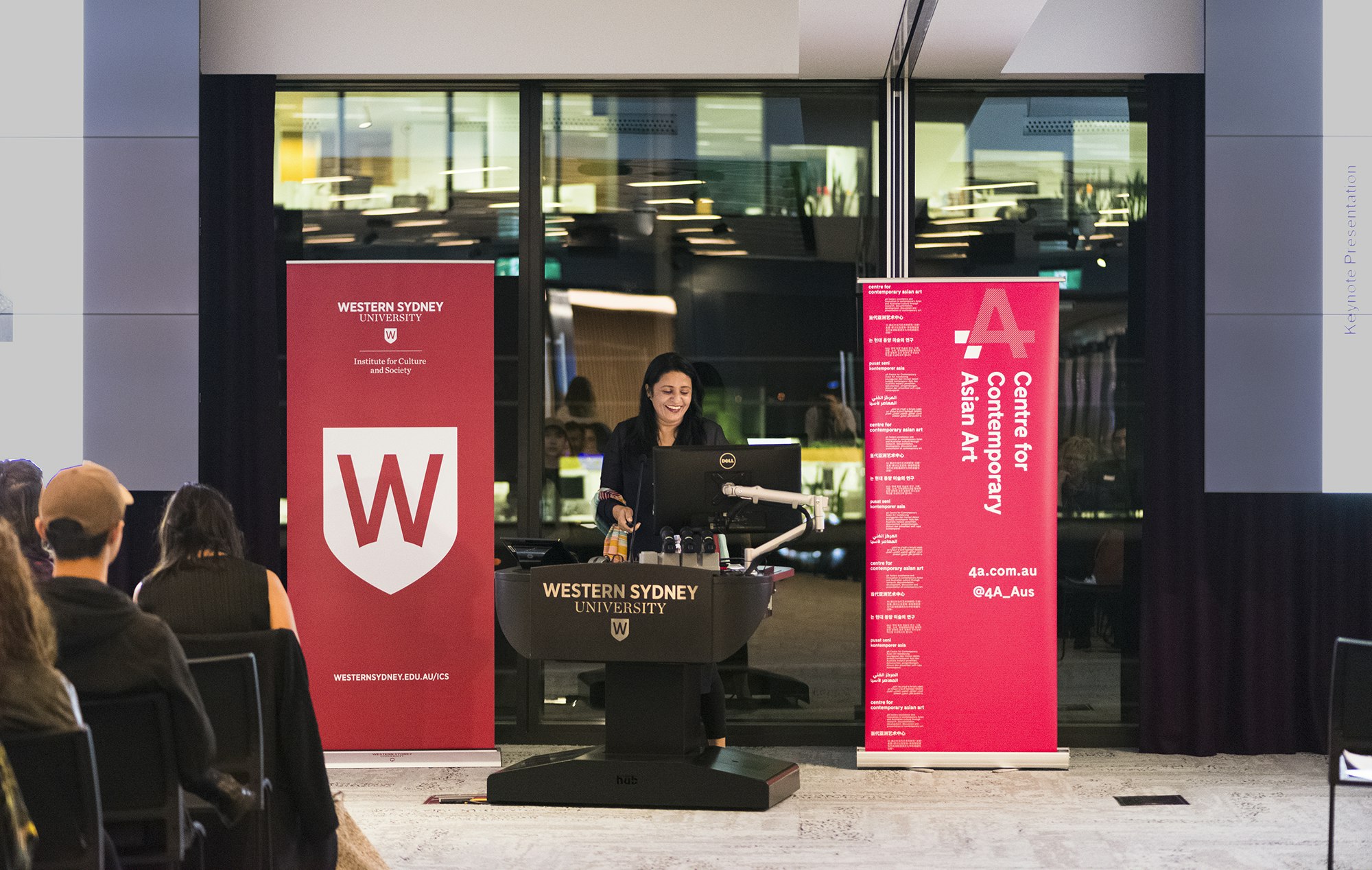
Adeela Suleman keynote address at When South is North: Contemporary Art and Culture in South Asia and Australia symposium, 16 August 2017, Western Sydney University, Parramatta campus. Produced by 4A Centre for Contemporary Asian Art in association with the Institute for Contemporary Culture and Society, Western Sydney University. Photo: Kai Wasikowski.
Keynote address: Adeela Suleman
‘Violence in the midst of creativity has strangely become less scary.’
In a place where violence is endemic, how does a person survive, mentally, emotionally and physically? How does an artist create, when death is both ever imminent and uncertain? What does she produce? For Adeela Suleman, associate professor at Karachi’s Indus Valley School of Art and head of its Fine Art Department, these are questions that haunt both daily living and artistic practice. In Karachi, Pakistan’s most populous city, assassinations, bomb explosions and terrorist attacks are routine, so routine that a tragedy in the morning is folded into Karachi residents’ psyches by evening, and the chaotic life of the city, momentarily halted by the violence, picks up and swirls on. This is not a reflection of callousness in this diverse and multiethnic city, but rather a testament to resistance, to resilience and the ‘sheer will to survive’. Suleman’s response is contained and revealed, among others, by the installations commissioned by 4A and supported by the Keir Foundation for the symposium’s companion exhibition, I don’t want to be there when it happens. The eponymous work, a large glittering chandelier hanging from the ceiling and nearly touching the floor, throws almost geometric shadows on the walls. The pieces constituting the chandelier are small dead birds, made of hand-beaten stainless steel and linked together. At the end of each long link hangs a small dagger, exquisitely engraved like the arms and armour of ancient Islamic warriors whom Suleman referenced in other work she discussed. Here it seemed as if their historically redemptive role in the name of justice had turned inwards to eviscerate the community. Suleman initially made the birds as an attempt to artistically record each daily death in Karachi. But the reality soon outstripped her capacity. So she created chandeliers and curtains with the dead birds, as much a requiem as a consciously executed instance of beauty belying violent cruelty.
Similarly, Suleman’s questioning whether violence was becoming fetishised as well as banal in Pakistan resulted in a controversial video installation where armed men play soccer with the heads of their executed captives, laughing and conversing as they would while playing a regular game. Linking such behaviour with the etching of violence into the fabric of places and landscapes, not just human memory, as well as the positioning of her own work, Suleman stated: ‘The more odious the crime, the more entertaining it becomes for the doer and the observer. The more beautiful the landscape, the more appalling the acts of terror and violence it experiences. The more heinous the crime, the more captivating and beautiful the monument.’ Refusing to ignore such terrible contradictions but at the same time surviving them, being creative, and engaging in activism are ingredients for an artist’s sanity amidst chaos. ‘Violence in the midst of creativity has strangely become less scary.’ To an audience question as to whether being an artist made her more resilient and able to be alert to a situation and respond, Suleman asserted that all Karachi residents are resilient, across class and ethnicity. While being aware of situational changes and taking precautions, people were determined to continue with their lives, and this vibrancy attracted artists from overseas to visit. To another question, whether she faced criticism for her highly political artistic work as poorly reflecting Pakistan abroad, Suleman responded that artists in Pakistan routinely faced such criticism. She believed in catalysing change, especially locally, by educating people through her art. Whose artistic criticism one took on depended on who was able to offer it in an unbiased way to enable artistic growth.
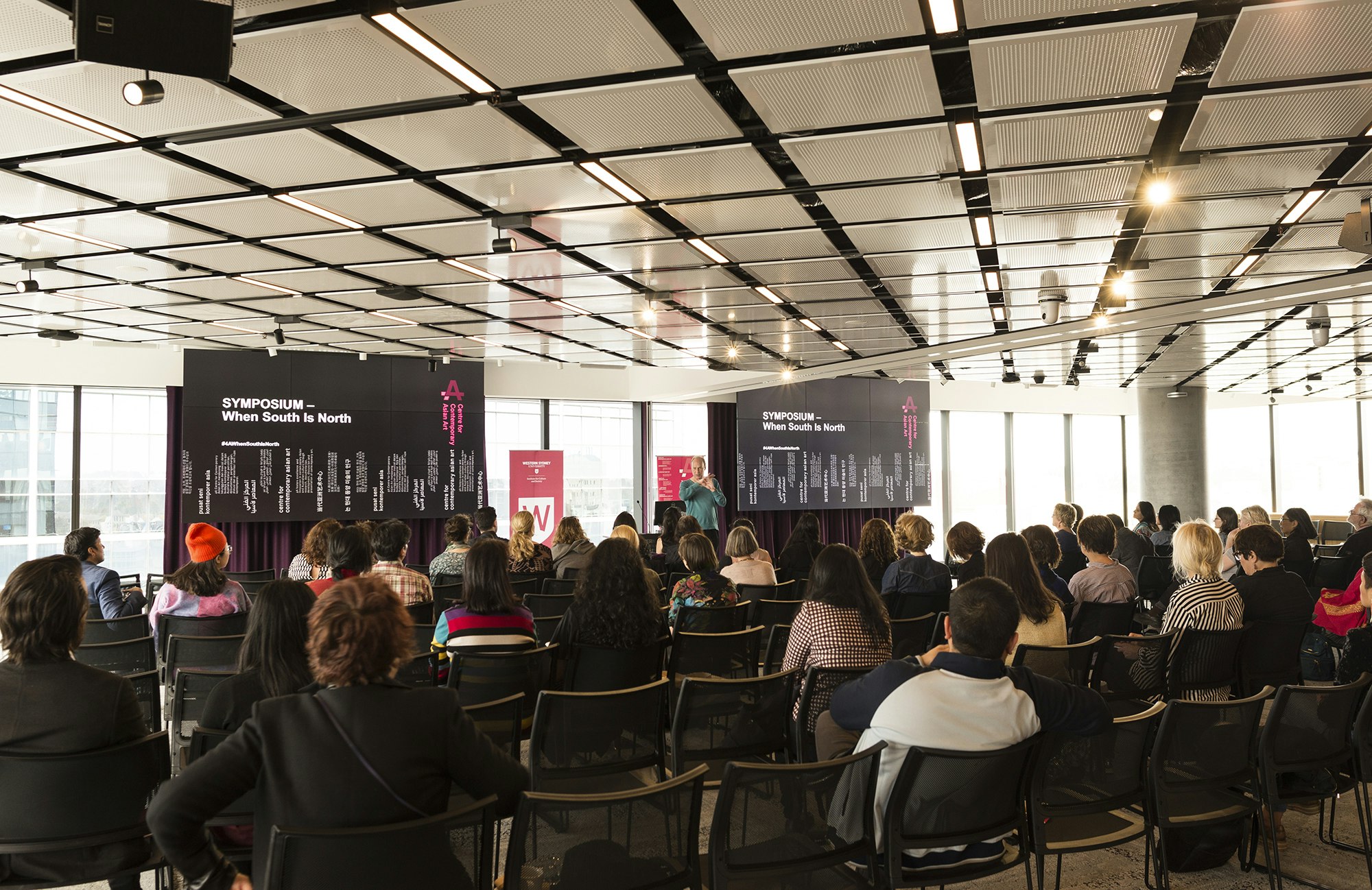
Professor Paul James opening When South is North: Contemporary Art and Culture in South Asia and Australia symposium, 16 August 2017, Western Sydney University, Parramatta campus. Produced by 4A Centre for Contemporary Asian Art in association with the Institute for Contemporary Culture and Society, Western Sydney University. Photo: Kai Wasikowski.
Reflections
In her concluding remarks, Distinguished Professor Ien Ang from the Institute for Culture and Society (ICS) at Western Sydney University reminded the audience of the range of complexities and contradictions to be considered when talking about South Asia. In Australia, although India was more likely to be centred in discussion because of its economic importance, events such as this symposium drew attention to the broader region. Countries are entities with borders, which are to be crossed if people are to be linked. Artists are among those leading such initiatives. ICS and 4A are enablers of hopeful discursive and artistic crossings, she said.
When South is North enabled glimpses into the concerns and work contexts of three different groups of people working in the arts and art organisations: those based in geographical South Asia, first-generation immigrants in Australia, and Australians of South Asian descent who grew up in Australia. The artists and arts administrators based in South Asia work in contexts of marked daily conflict, whether political, social or economic, often intense and even life-threatening. The conflicts and contradictions inform artistic output and interventions that local art organisations support. Art collectives and networks, both in-country and regional, are vital to sustaining artistic production. The networks that reach over national boundaries play critical roles enabling artists from countries that have long-standing hostilities to nevertheless connect as artists. Where state institutions have been sluggish in supporting contemporary art, private art galleries and international art fairs have compensated, offering artists exposure on globally accessible platforms.
Australia is a space that is relatively secure, politically and economically. Consequently, artists’ struggles may be affected differently than in South Asia. Artists who are first-generation immigrants sometimes face the onus of having to prove their credibility before being picked up for exhibition in Australia. As Qureshi indicated, this other ‘passport’ is a track record of shows at noted venues overseas, especially in Europe or North America. Being identified as ‘Australian’ is also tentative, potentially placing them in a no-person’s land. Australians of South Asian descent who grew up here battle on two fronts: in opposition to their parental generation which may have a frozen notion of South Asian culture, and in opposition to predominantly white or otherwise mainstream cultural institutions that deny them opportunities to lead processes towards constructing an Australian cultural space which more honestly reflects the country’s lived diversity.
While South Asian-Australian artists are engaged in developing people-to-people networks across national boundaries, art organisations in Australia can also facilitate this by creating opportunities for artists from South Asia to meet one another, as well as Australian artists, in a third space. Such a space could be within Australia, but issues such as the swift provision of visas will require attention. The efforts of art organisations such as 4A to promote ties with South Asia exemplify Australians’ capacity for effective cultural diplomacy in the Indo-Pacific region, and the productive consequences of cross-border cultural flows as discussed in the 2015 report Smart Engagement with Asia: Leveraging language, research and culture, co-authored by Ien Ang, Phillip Mar and myself. At the same time, the provision of opportunity for South Asian-Australians to be in positions of cultural leadership will enable Australia to realise diversity systemically. Both these initiatives will be as much a benefit to the country’s growing ties with geographical South Asia as it will be to invigorating Australian art through a broader representation of Asia in Australia.
Notes
When South is North: Contemporary Art and Culture in South Asia and Australia was a one-day symposium produced and presented by 4A Centre for Contemporary Asian Art in association with the Institute for Culture and Society at Western Sydney University. Presented at 1 Parramatta Square, Western Sydney University campus, Parramatta, on 16 August 2017. The symposium was assisted by the Australian Government through the Australia Council for the Arts, its arts funding and advisory body. Adeela Suleman’s participation in this symposium and 4A exhibition I don’t want to be there when it happens was supported by co-commissioning partner The Keir Foundation with additional assistance from Sherman Foundation.
View the full program and biographies of symposium speakers here.
Listen to audio recordings of the full symposium here.

About the contributor
Dr Yasmin Tambiah was born and grew up in Sri Lanka, and lived there intermittently as an adult during the long war between the Government of Sri Lanka and the Liberation Tigers of Tamil Eelam.
